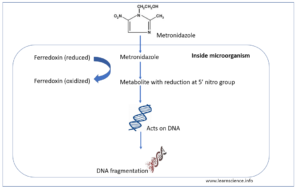- Metronidazole is an antibiotic widely used in various bacterial and protozoal infections.
- It is a nitroimidazole derivative. It was first introduced in France in 1960 and since then, it had become one of the most important anti-microbial medicine.
- Metronidazole is even included in World Health Organization’s List of Essential Medicines.
Mechanism of action of metronidazole

Figure 1- Mechanism of action of Metronidazole
- Metronidazole is a pro drug which is activated by reduction of its nitro group.
- Anaerobic and microaerophilic pathogens contain ferredoxin like, low redox potential, electron transport proteins that donate electrons to metronidazole and cause reduction of 5’ nitro group of metronidazole. This form reduced, short living cytotoxic compounds bind to microbial proteins and DNA resulting in lethal effect.
- It has antibacterial activity against all anaerobic cocci and both anaerobic gram-negative bacilli, including Bacteroides spp., and anaerobic spore-forming gram-positive bacilli.
- It is not activated by aerobes and hence, is not effective against them.
Resistance
- Metronidazole resistance is reported in vaginalis and G. lamblia.
- Mechanism of resistance is complex. It involves reduced rate of drug uptake, by efflux or by reducing rate of reductive activation of metronidazole by altering pyruvate fermentation.
Pharmacokinetics of metronidazole
- It can be administered through oral, intravenous, intravaginal or topical administration. After oral administration, it undergoes rapid and almost completelabsorbed (80%) absorption . Its bioavailability is not affected by food.
- After an oral administration, peak serum concentration reaches within 1 hour of administration.
- Protein binding is about 20%. It is distributed in all tissues and fluids including CSF (Cerebrospinal fluid), bile, bone, vaginal secretion, seminal fluid and abscesses. It doesn’t penetrate placenta.
- Metronidazole is mainly metabolized in liver into inactive acid metabolite; and a hydroxy metabolite active against anaerobes. Its t½ is 8 hours. Its half-life may be prolonged in hepatic patients.
- After an oral dose, >75% of labeled metronidazole is eliminated in the urine as metabolites; only ~10% is recovered as unchanged drug. The metabolites may impart red color to urine in some patients. Its half-life is not significantly altered in renal insufficiency. However, half-life of hydroxy metabolite increases 4-fold and may accumulate in serum.
Therapeutic Uses of metronidazole
- Used to treat intestinal and hepatic amoebiasis.
- In prophylaxis and treatment of infections caused by non-sporing, gram-negative anaerobes like bacterial vaginosis, pseudomembranous colitis.
- In trichomoniasis and giardiasis.
- Used to treat H. pylori infection.
- In ulcerative gingivitis caused by spirochete Treponema vincenti and gram-negative bacilli Leptotrichia buccalis.
- In dracunculosis (guinea worm). It helps in worm extraction rather than killing them.
- Used in combination with other anti-microbial agents to treat polymicrobial infections with aerobic and anaerobic bacteria.
- To treat infection in patients who have underwent surgery.
Adverse Effects
- It is well tolerated with mild to moderate side effects.
- Most common side effects are headache, nausea, dry mouth, abdominal pain and metallic taste in mouth. Vomiting, urticaria, pruritus, flushing and diarrhea are experienced occasionally.
- Neurotoxic side effects like dizziness, vertigo and very rarely seizures, ataxia, encephalopathy and incoordination may lead to metronidazole discontinuation.
- It has disulfiram like effect. If patient drink alcoholic beverages during or within 3 days of therapy, they may experience headache, vomiting, flushing or abdominal distress.
- The nitro group of drugs may cause mild blood dyscrasia in the form of neutropenia. It is reversible.
Drug Interaction
- It potentiates CNS signs of lithium toxicity when administered together.
- When administered together with coumarin anticoagulants, it prolongs prothrombin time.
- Concurrent administration of cytochrome P450 enhancer like phenobarbital increases its rate of metabolism and inducer like cimetidine decreases its rate of metabolism.
- It produces disulfiram like reaction when taken with alcohol by inhibiting acetaldehyde dehydrogenase- an enzyme responsible for metabolizing alcohol.
Contraindication and Clinical consideration
- It should be contraindicated in patients who are allergic or hypersensitive to metronidazole.
- Should be used with caution in patients with active CNS disease due to potential neurotoxic effects.
- Its dose should be reduced in hepatic patients.
References
- https://www.merckvetmanual.com/pharmacology/antibacterial-agents/nitroimidazoles
- Ralph ED. Clinical Pharmacokinetics of Metronidazole. Clinical Pharmacokinetics. 1983; 8: 43–62.
- Ceruelos H, Quezada LCR, Ledezma R, Contreras LL. Therapeutic uses of metronidazole and its side effects: an update. Eur rev med Pharmacol Sci. 2019; 23(1): 397-401.
- Youssef I, saeed N, Abdallah ME, Huevelhorst K, Zakharia K. Metronidazole-Induced Pancreatitis: Is There Underrecognition? A Case Report and Systematic Review of the Literature Case Rep. Gastrointest Med. 2019; 2019: 4840539.
- Dingsdag SA, Hunter N. Metronidazole: an update on metabolism, structure–cytotoxicity and resistance mechanisms. Journal of Antimicrobial Chemotherapy. 2018; 73(2): 265–279.
- Pharmacology and Pharmacotherapeutics. 24th edition.
- Lippincott Illustrated Reviews Pharmacology, 6th edition.
- Goodman and Gillman’s Manual of Pharmacology.
excellent information continouse this information go ahead
excellent information continouse this information go ahead and so any defferent drugs pharmacology so on
Thank you. Please, keep visiting our website.